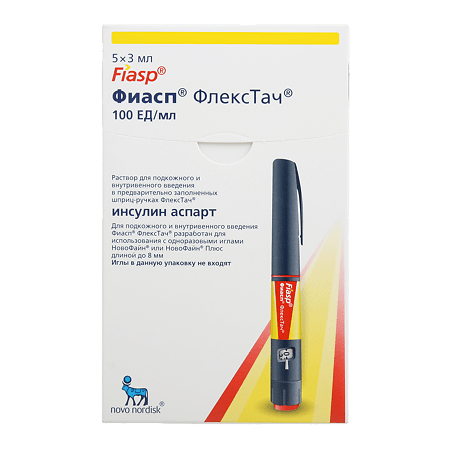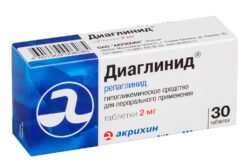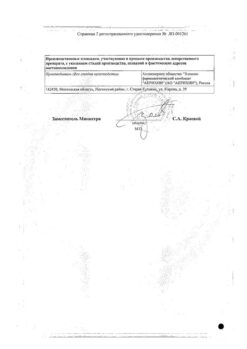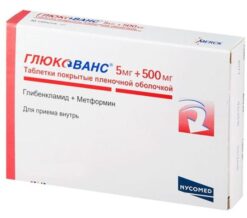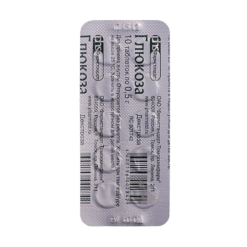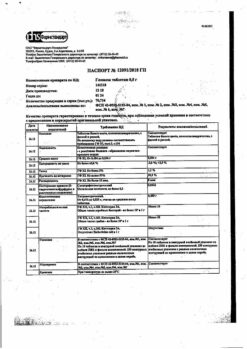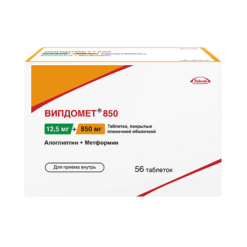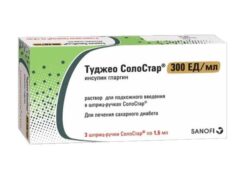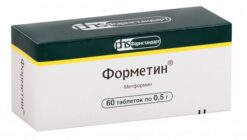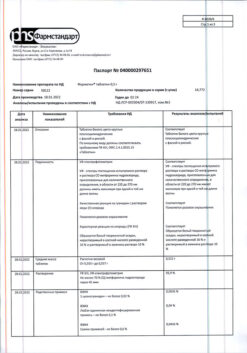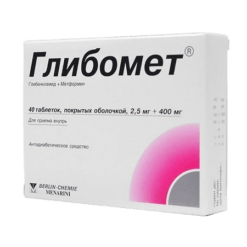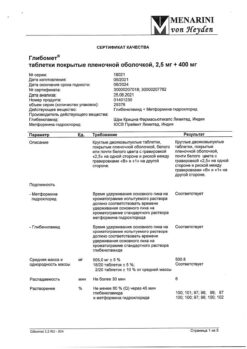No products in the cart.
Fiasp, 100 units/ml 3 ml cartridges in Flextach syringe pens 5 pcs.
€1.00
Out of stock
(E-mail when Stock is available)
Description
Pharmacotherapeutic group:mHypoglycemic agent, short-acting human insulin analogue.
ATX code: A10AB05.
Pharmacological properties:
The drug Fiasp® is an ultrafast-acting human insulin analog produced by recombinant DNA biotechnology using the Saccharomyces cerevisiae strain.
The main pharmacological action of insulin aspart is regulation of glucose metabolism. Insulins, including insulin aspart, the active ingredient of Fiasp®, exert their specific action by binding to insulin receptors. The hypoglycemic effect of insulin aspart is due to an increase in tissue glucose utilization after insulin binds to muscle and fat cell receptors and to a decrease in liver glucose production. Insulin suppresses lipolysis in adipocytes, suppresses proteolysis and increases protein synthesis.
Pharmacodynamics
. Fiasp® is a direct-to-meal insulin aspart that contains nicotinamide (vitamin B3), which provides faster initial absorption of insulin, resulting in earlier onset of action and significantly earlier hypoglycemic effects compared to NovoRapid®.
The Fiasp® drug begins to act 5 minutes faster and the maximum glucose infusion level is reached 11 minutes earlier compared to NovoRapid®. Blood glucose concentration reduction values during the first 30 minutes (AUCGIR, 0-30 min) were 51 mg/kg when using Fiasp® and 29 mg/kg when using NovoRapid®.
The total hypoglycemic and maximum (GIRmax) hypoglycemic effects were comparable when using Fiasp® and NovoRapid®. Total and maximum hypoglycemic effects of Fiasp® increase in proportion to increasing the dose within the therapeutic dose range.
The duration of action of the drug Fiasp® is shorter than that of NovoRapid® and lasts 3-5 hours. Late hypoglycemic effect of Fiasp® was 10% less compared to that of NovoRapid®.
The drug Fiasp® administered immediately before a meal leads to a significantly greater hypoglycemic effect after a standardized meal compared to the drug NovoRapid®. The difference in glucose increment reduction within two hours of a meal was statistically significant and greater with Fiasp® (-0.67 mmol/L [-1.29; -0.04]95% CI). The difference in the rate of decrease in glucose concentration increase within one hour of meal was -1.18 mmol/L [-1.65; -0.71]95% CI, consistent with the earlier absorption profile of Fiasp®.
The intraindividual variability in day-to-day hypoglycemic effects was low for Fiasp® for both early (AUCGIR, 0-1h, CV~26%), total (AUCGIR, 0-12h, CV~18%) and maximum (GIRmax, CV 19%) hypoglycemic effects.
Long-term subcutaneous insulin infusions (SPII)
During SPII, Fiasp® demonstrated a greater hypoglycemic effect after standardized meal intake with respect to one and two hour postmeal glucose concentration increments (difference: -0.50 mmol/L [-1.07; 0.07]95% CI and -0.99 mmol/L [-1.95; -0.03]95% CI, respectively, compared with NovoRapid®.
Elderly Patients
In elderly patients with type 1 diabetes mellitus (DM1), Fiasp® demonstrated earlier onset of action and significantly earlier hypoglycemic effects while maintaining similar overall and maximal hypoglycemic effects compared to NovoRapid®.
The total and maximal hypoglycemic effects with Fiasp® were comparable in elderly patients and younger adult patients.
Obesity
The effect of body mass index (BMI) on the pharmacodynamics of Fiasp® was studied in a cross-sectional analysis of pharmacodynamic studies. In patients with DM1, Fiasp® demonstrated earlier hypoglycemic effects while maintaining similar overall and maximal hypoglycemic effects compared to NovoRapid® regardless of BMI.
There was a tendency to decrease the hypoglycemic effect of Fiasp® with increasing BMI in patients with DM1.
Children and adolescents
As compared to NovoRapid® in children, the hypoglycemic effect of Fiasp® was higher by more than 30%, which was confirmed by mean changes in plasma glucose concentration at 1 and 2 hours after meal.
There is no clinically significant difference in pharmacodynamic properties of Fiasp® in children (6-11 years), adolescents (12-18 years) and adult patients with DM1.
Clinical efficacy and safety
The use of Fiasp® was studied in 2,068 randomized adult patients with DM1 (1,143 patients) and with type 2 diabetes (DM2) (925 patients) in three long-term (18-26 weeks of therapy) clinical trials (Trial) of efficacy and safety.
Patients with DM1
The drug Fiasp® was effective in achieving glycemic control when used during or after meals.
The decrease in HbA1c was statistically more significant with Fiasp® at meal time compared to NovoRapid®.
In patients with DM1, Fiasp® provided greater overall glycemic control compared to NovoRapid®. Fiasp® compared to NovoRapid® provided better glycemic control after meals without increasing the overall risk of severe or confirmed hypoglycemia in patients with DM1 and DM2.
Patients with DM2
The drug Fiasp® has been effective in achieving glycemic control in patients with DM2.
The addition of Fiasp® to basal insulin administered once daily in conjunction with metformin resulted in greater reductions in HbA1c and a statistically significant reduction in post-meal glucose concentrations in DM2 patients compared with basal insulin therapy administered once daily in conjunction with metformin.
Elderly Patients
In three controlled CIs, 192 of 1,219 (16%) patients with DM1 or DM2 treated with Fiasp® were ≥65 years of age and 24 of 1,219 (2%) were ≥75 years of age. Overall, there were no differences in safety or efficacy between older and younger adult patients.
PIPI
A randomized (2:1) double-blind, parallel-group, active-controlled, 6-week comparison study of Fiasp® and NovoRapid® for PIPI in adult patients with DM1 was conducted.
For both Fiasp® (n=25) and NovoRapid® (n=12), there were no episodes of infusion set occlusion, as confirmed by microscopic examination. Two patients in the Fiasp® group reported therapy-related reactions at the injection site.
Pharmacokinetics
Intake
. Subcutaneous (p/k) bolus injection of ultrafast-acting insulin aspart or PPIs using an insulin pump results in earlier onset of action and significantly earlier hypoglycemic effects compared to NovoRapid®.
Insulin appears in the bloodstream approximately 4 minutes after administration of Fiasp®. Onset of blood insulin was twice as fast (5 minutes earlier) and the time to reach 50% of maximum concentration was 9 minutes shorter with Fiasp® compared to NovoRapid®, resulting in a fourfold increase in available insulin during the first 15 minutes and twice as much during the first 30 minutes. Total insulin exposure (AUCinsulin aspart, 0-12 hours) and maximum insulin concentration (Cmax) were comparable between Fiasp® and NovoRapid®. Total exposure and maximum insulin concentration increased in proportion to the Fiasp® p/k dose administered within the therapeutic dose range.
The absolute bioavailability of insulin aspart after b/c administration of Fiasp® to the anterior abdominal wall, deltoid and thigh was approximately 80%.
The rapid emergence of Fiasp® in the bloodstream was maintained regardless of the site of administration.
The time to maximum concentration and total exposure to insulin aspart were comparable when injected into the anterior abdominal wall, deltoid muscle area and thigh. Early insulin exposure and maximum concentration were comparable when injected into the anterior abdominal wall and shoulder, but lower when injected into the thigh.
PIPI
The onset of exposure (time to reach maximum concentration) for PIPI was 26 minutes shorter with Fiasp® compared with NovoRapid®, resulting in an approximately threefold increase in available insulin during the first 30 minutes. Exposure duration (time to late 50% Cmax) was 35 minutes shorter with Fiasp® compared to NovoRapid®.
Distribution
Insulin aspart has a low affinity for binding to plasma proteins (<10%) similar to that observed with regular human insulin.
The volume of distribution (Vd) after intravenous (IV) administration is 0.22 L/kg (i.e. 15.4 L for a 70 kg person), which corresponds to the volume of extracellular fluid in the human body.
Metabolism
The metabolism of insulin aspart is similar to that of human insulin; all metabolites formed are inactive.
Elimation
Fiasp® has a half-life of 57 minutes after oral administration and is comparable to that of NovoRapid®.
The intravenous administration of Fiasp® is characterized by fast clearance (1.0 l/h/kg). The half-life after IV administration is 10 minutes.
Particular patient groups
Elderly patients
In comparison with NovoRapid® in elderly DM1 patients, Fiasp® demonstrated earlier onset of exposure and higher early insulin exposure while maintaining similar overall exposure and maximum concentration.
The total exposure to insulin aspart and maximum concentration after administration of Fiasp® was 30% higher in older patients compared to younger adult patients.
Pass
The effect of sex on the pharmacokinetics of Fiasp® was tested in a cross-sectional analysis of pharmacokinetic studies. Compared with NovoRapid®, Fiasp® demonstrated comparable early onset of exposure and higher early insulin exposure while maintaining similar overall exposure and maximum concentration for both women and men with DM1.
The early and maximum insulin exposures to Fiasp® were comparable in women and men with DM1. However, total insulin exposure was greater in women with DM1 compared to men with DM1.
Race and ethnicity
The effect of race and ethnicity (blacks vs. Caucasians, Hispanics vs. other ethnicities) on total insulin exposure to Fiasp® was based on results of a population pharmacokinetic analysis in patients with DM1. No difference in Fiasp® exposure was found between the racial and ethnic groups studied.
Help Failure
A single-dose pharmacokinetic study of aspart insulin was performed in 24 patients with normal to severe hepatic function. In patients with hepatic insufficiency, the absorption rate was reduced and was more variable.
Renal insufficiency
The effect of renal insufficiency on total insulin exposure to Fiasp® was based on results of a population pharmacokinetic analysis in patients with DM1. Renal function by creatinine clearance (CK) was defined as: normal – CK ≥ 90 ml/min (N=546), mild renal failure – CK 60-89 ml/min (N=115), moderate renal failure – CK 30-59 ml/min (N=21). When renal function decreased, a higher total exposure of Fiasp® was observed. However, some interindividual variability in total exposure was observed among patients with DM1 and mild to moderate renal failure. Thus, in patients with renal insufficiency, as with all insulin drugs, blood glucose concentrations should be monitored more closely and the dose of Fiasp® should be adjusted individually.
Children and adolescents
In comparison with NovoRapid® in children (6-11 years) and adolescents (12-18 years), Fiasp® demonstrated earlier onset of exposure and higher early insulin exposure while maintaining similar overall exposure and maximum concentration.
The onset of action and early exposure of Fiasp® are similar in children and adolescents to those in adults.
In children and adolescents, at a dose of 0.2 IU/kg body weight, total Fiasp® exposure was lower compared to adults, while the maximum plasma concentration of insulin aspart was similar.
Indications
Indications
Treatment of diabetes mellitus in adult patients.
Pharmacological effect
Pharmacological effect
Pharmacotherapeutic group: hypoglycemic agent, analogue of short-acting human insulin.
ATX code: A10AB05.
Pharmacological properties:
The drug Fiasp® is an ultra-fast-acting analogue of human insulin, produced by recombinant DNA biotechnology using the Saccharomyces cerevisiae strain.
The main pharmacological action of insulin aspart is the regulation of glucose metabolism. Insulins, including insulin aspart, the active ingredient in Fiasp®, exert their specific effect by binding to insulin receptors. The hypoglycemic effect of insulin aspart is due to an increase in the utilization of glucose by tissues after binding of insulin to the receptors of muscle and fat cells, and a decrease in the rate of glucose production by the liver. Insulin suppresses lipolysis in adipocytes, suppresses proteolysis and enhances protein synthesis.
Pharmacodynamics
The drug Fiasp® is insulin aspart for administration in direct connection with meals, containing nicotinamide (vitamin B3), which ensures faster initial absorption of insulin, which leads to an earlier onset of action and a significantly earlier hypoglycemic effect compared to the drug NovoRapid®.
The drug Fiasp® begins to act 5 minutes faster, and the maximum level of glucose infusion is reached 11 minutes earlier compared to the drug NovoRapid®. The decrease in blood glucose concentration during the first 30 minutes (AUCGIR, 0-30 min) when using the drug Fiasp® was 51 mg/kg, when using the drug NovoRapid® – 29 mg/kg.
The total hypoglycemic and maximum (GIRmax) hypoglycemic effects were comparable when using Fiasp® and NovoRapid®. The overall and maximum hypoglycemic effects of Fiasp® increase proportionally with increasing doses within the therapeutic dose range.
The duration of action of Fiasp® is shorter than that of NovoRapid®, lasting 3-5 hours. The late hypoglycemic effect of Fiasp® was 10% less than that of NovoRapid®.
The drug Fiasp®, administered immediately before a meal, leads to a significantly greater hypoglycemic effect after a standardized meal compared to the drug NovoRapid®. The difference in the decrease in the increase in glucose concentration within two hours after a meal was statistically significant and greater when using the drug Fiasp® (-0.67 mmol/l [-1.29, -0.04]95% CI). The difference in the decrease in the increase in glucose concentration within one hour after eating was -1.18 mmol/l [-1.65; -0.71]95% CI, which corresponds to an earlier absorption profile of Fiasp®.
Intra-individual variability from day to day in the hypoglycemic effect was low for Fiasp® for both early (AUCGIR, 0-1h, CV~26%), total (AUCGIR, 0-12h, CV~18%), and maximum (GIRmax, CV 19%) hypoglycemic effects.
Continuous subcutaneous insulin infusion (CSII)
During CSII, Fiasp® demonstrated a more significant hypoglycemic effect after a standardized meal in terms of the increase in glucose concentration within one and two hours after meals (difference: -0.50 mmol/l [-1.07, 0.07]95% CI and -0.99 mmol/l [-1.95, -0.03]95% CI, respectively, compared with the drug NovoRapid®.
Elderly patients
In elderly patients with type 1 diabetes mellitus (T1DM), Fiasp® demonstrated an earlier onset of action and a significantly earlier hypoglycemic effect while maintaining similar overall and maximum hypoglycemic effects compared to NovoRapid®.
The overall and maximum hypoglycemic effects with Fiasp® were comparable in elderly patients and younger adult patients.
Obesity
The effect of body mass index (BMI) on the pharmacodynamics of Fiasp® was studied in a cross-sectional analysis of pharmacodynamic studies. In patients with type 1 diabetes, the drug Fiasp® demonstrated an earlier hypoglycemic effect while maintaining similar overall and maximum hypoglycemic effects compared to the drug NovoRapid®, regardless of the BMI value.
There was a tendency for the hypoglycemic effect of Fiasp® to decrease with increasing BMI in patients with type 1 diabetes.
Children and teenagers
Compared with the drug NovoRapid® in children, the hypoglycemic effect of the drug Fiasp® was higher by more than 30%, which was confirmed by average changes in plasma glucose concentrations 1 and 2 hours after meals.
There is no clinically significant difference in the pharmacodynamic properties of the drug Fiasp® in children (6-11 years), adolescents (12-18 years) and adult patients with T1DM.
Clinical efficacy and safety
The use of Fiasp® was studied in 2068 randomized adult patients with T1DM (1143 patients) and type 2 diabetes mellitus (T2DM) (925 patients) in three long-term (18-26 weeks of therapy) clinical studies (CT) of efficacy and safety.
Patients with T1DM
Fiasp® was effective in achieving glycemic control when administered during or after meals.
When using the drug Fiasp® during meals, the decrease in HbA1c was statistically more significant compared to the drug NovoRapid®.
In patients with T1DM, Fiasp® provided greater overall glycemic control compared to NovoRapid®. Fiasp® compared to NovoRapid® provided better glycemic control after meals without increasing the overall risk of severe or confirmed hypoglycemia in patients with T1DM and T2DM.
Patients with T2DM
Fiasp® was effective in achieving glycemic control in patients with T2DM.
The addition of Fiasp® to once-daily basal insulin with metformin resulted in a greater reduction in HbA1c and a statistically significant reduction in postprandial glucose concentrations in patients with T2DM compared with once-daily basal insulin plus metformin.
Elderly patients
In three controlled trials, 192 of 1219 (16%) patients with T1DM or T2DM treated with Fiasp® were aged ≥65 years and 24 of 1219 (2%) were aged ≥75 years. Overall, no differences in safety and effectiveness were observed between older and younger adult patients.
PPII
A randomized (2:1), double-blind, parallel-group, active-controlled, 6-week comparison study of Fiasp® and NovoRapid® for CSII in adult patients with T1DM was conducted.
Both when using the drug Fiasp® (n=25) and when using the drug NovoRapid® (n=12), there were no episodes of blockage of the infusion set, which was confirmed by microscopic examination. Two patients in the Fiasp® group reported treatment-related reactions at the injection site.
Pharmacokinetics
Suction
Subcutaneous (SC) bolus administration of rapid-acting insulin aspart or CSII using an insulin pump results in an earlier onset of action and a significantly earlier hypoglycemic effect compared to NovoRapid®.
Insulin appears in the bloodstream approximately 4 minutes after administration of Fiasp®. The onset of insulin in the blood occurred twice as quickly (5 minutes earlier), the time to reach 50% of the maximum concentration was 9 minutes shorter with Fiasp® compared to NovoRapid®, which led to an increase in available insulin fourfold during the first 15 minutes and twofold during the first 30 minutes. Total insulin exposure (AUCinsulin aspart, 0-12 hours) and maximum insulin concentration (Cmax) were comparable between Fiasp® and NovoRapid®. The total exposure and maximum insulin concentration increase in proportion to the administered subcutaneous dose of Fiasp® within the therapeutic dose range.
The absolute bioavailability of insulin aspart after subcutaneous injection of Fiasp® into the anterior abdominal wall, deltoid muscle area and thigh was approximately 80%.
The rapid appearance of Fiasp® in the bloodstream was maintained regardless of the injection site.
The time to maximum concentration and total exposure of insulin aspart were comparable when administered into the anterior abdominal wall, deltoid region and thigh. Early insulin exposure and maximum concentration were comparable when administered into the anterior abdominal wall and shoulder, but lower when administered into the thigh.
PPII
The onset of exposure (time to peak concentration) with CSII was 26 minutes shorter with Fiasp® compared to NovoRapid®, resulting in an approximately threefold increase in available insulin during the first 30 minutes. The duration of exposure (time to late 50% Cmax) was 35 minutes shorter with Fiasp® compared to NovoRapid®.
Distribution
Insulin aspart has a low affinity for plasma protein binding (<10%), similar to that observed with regular human insulin.
The volume of distribution (Vd) after intravenous (IV) administration is 0.22 L/kg (i.e. 15.4 L for a 70 kg person), which corresponds to the volume of extracellular fluid in the human body.
Metabolism
The metabolism of insulin aspart is similar to that of human insulin; all metabolites formed are inactive.
Removal
After subcutaneous administration, the half-life of Fiasp® is 57 minutes and is comparable to that of NovoRapid®.
IV administration of the drug Fiasp® is characterized by rapid clearance (1.0 l/h/kg). The half-life after intravenous administration is 10 minutes.
Special patient groups
Elderly patients
Compared with NovoRapid® in elderly patients with T1DM, Fiasp® demonstrated an earlier onset of exposure and higher early insulin exposure while maintaining similar total exposure and maximum concentrations.
Total exposure to insulin aspart and maximum concentration after administration of Fiasp® were 30% higher in elderly patients compared to younger adult patients.
Floor
The effect of gender on the pharmacokinetics of Fiasp® was tested in a crossover analysis of pharmacokinetic studies. Compared with NovoRapid®, Fiasp® demonstrated comparable early onset of exposure and higher early insulin exposure while maintaining similar total exposure and peak concentrations for both women and men with T1DM.
Early and maximum insulin exposures to Fiasp® were comparable in women and men with T1DM. However, total insulin exposure was greater in women with T1DM compared with men with T1DM.
Race and ethnicity
The effect of race and ethnicity (Blacks versus Caucasians, Hispanics versus other ethnicities) on total insulin exposure to Fiasp® was based on the results of a population pharmacokinetic analysis in patients with T1DM. There were no differences in exposure to Fiasp® between the racial and ethnic groups studied.
Liver failure
A pharmacokinetic study of a single dose of insulin aspart was conducted in 24 patients with normal to severe liver function. In patients with hepatic impairment, the rate of absorption was reduced and more variable.
Kidney failure
The effect of renal impairment on total insulin exposure to Fiasp® was based on the results of a population pharmacokinetic analysis in patients with type 1 diabetes. Renal function according to creatinine clearance (CC) was defined as: normal – CK ≥ 90 ml/min (N=546), mild renal failure – CK 60-89 ml/min (N=115), moderate renal failure – CK 30-59 ml/min (N=21). With decreased renal function, a higher total exposure to Fiasp® was observed. However, among patients with T1DM and mild to moderate renal impairment, some interindividual variability in total exposure was observed. Thus, in patients with renal failure, as with all insulin preparations, the concentration of glucose in the blood should be more carefully monitored and the dose of Fiasp® should be adjusted individually.
Children and teenagers
Compared with NovoRapid® in children (6-11 years) and adolescents (12-18 years), Fiasp® demonstrated earlier onset of exposure and higher early insulin exposure while maintaining similar overall exposure and peak concentrations.
The onset of action and early exposure to Fiasp® are similar in children and adolescents, with similar rates in adults.
In children and adolescents, when administered at a dose of 0.2 U/kg body weight, the total exposure to Fiasp® was lower compared to adults, while the maximum plasma concentration of insulin aspart was similar.
Special instructions
Special instructions
Hypoglycemia
When skipping meals or unplanned intense physical activity, the patient may develop hypoglycemia.
Hypoglycemia may develop if a dose of insulin is administered that is too high in relation to the patient’s needs (see Side effects and Overdose).
After significant improvement in glycemic control (for example, with intensified insulin therapy), patients may experience changes in their typical symptoms that are precursors of hypoglycemia, of which patients should be informed. The usual warning symptoms may disappear with long-term diabetes.
The timing of the development of hypoglycemia usually corresponds to the action profile of the administered insulin drug. The drug Fiasp® has a characteristic time-dependent action profile (see Pharmacokinetics), which affects the timing of the development of hypoglycemia. A consequence of the pharmacodynamic properties of the drug Fiasp® is that the development of hypoglycemia with its use may begin earlier than with other insulin preparations administered during meals.
Since Fiasp® should be administered 2 minutes before or within 20 minutes after the start of a meal, the time of onset of action of the drug must be taken into account when used in patients with concomitant diseases or therapy that may reduce the rate of absorption of food.
Dose adjustment of the drug may be required if the patient has concomitant diseases of the kidneys, liver or dysfunction of the adrenal glands, pituitary gland or thyroid gland.
Hyperglycemia
Insufficient dosing or discontinuation of treatment, especially in patients who require insulin, may lead to the development of hyperglycemia or diabetic ketoacidosis, conditions that can be fatal.
PPII
Malfunctions of the insulin pump or infusion set can lead to rapid onset of hyperglycemia and ketosis. Prompt identification and correction of hyperglycemia or ketosis is necessary. Temporary therapy with the drug in the form of subcutaneous injections may be required.
Concomitant diseases
Concomitant diseases, especially infectious ones and those accompanied by fever, usually increase the body’s need for insulin. Dose adjustment of the drug may also be required if the patient has concomitant diseases of the kidneys, liver or dysfunction of the adrenal glands, pituitary gland or thyroid gland.
Simultaneous use of drugs of the thiazolidinedione group and insulin drugs
Cases of the development of chronic heart failure (CHF) have been reported when patients were treated with thiazolidinediones in combination with insulin drugs, especially if such patients have risk factors for the development of CHF. This fact should be taken into account when prescribing combination therapy with thiazolidinediones and insulin drugs to patients. When prescribing such combination therapy, it is necessary to conduct medical examinations of patients to identify signs of CHF, weight gain and the presence of edema. If patients’ symptoms of heart failure worsen, treatment with thiazolidinediones should be discontinued.
Initiation of insulin therapy and intensification of glycemic control
Intensification or acute improvement in glycemic control has been associated with transient, reversible refractive error, worsening diabetic retinopathy, acute painful peripheral neuropathy, and peripheral edema. However, long-term improvements in glycemic control reduce the risk of progression of diabetic retinopathy and neuropathy.
Antibodies to insulin
When using insulin, the formation of antibodies is possible. In rare cases, the formation of antibodies may require adjustment of the insulin dose to prevent cases of hyperglycemia or hypoglycemia.
Preventing accidental errors when using insulin medications
The patient should be instructed to check the label before each injection to avoid accidental confusion between Fiasp® and another insulin.
Before administering Fiasp®, patients should visually check the number of dose units administered. Thus, only patients who can clearly distinguish the numbers on the dose scale should self-administer insulin. Blind patients or people with low vision should be informed that they always need the assistance of persons who do not have vision problems and are trained in the technique of administering insulin.
Long trip due to jet lag
Before a long trip due to jet lag, the patient should consult with his or her physician.
Fertility
Animal reproductive studies have shown no differences between insulin aspart and human insulin with regard to fertility.
Impact on the ability to drive vehicles and machinery
With hypoglycemia, patients’ ability to concentrate and reaction speed may be impaired. This can be dangerous in situations where these abilities are especially needed (for example, when driving or operating machinery).
Patients should be advised to take measures to prevent the development of hypoglycemia when driving or operating machinery. This is especially important for patients with no or decreased severity of symptoms that predict hypoglycemia or with frequent episodes of hypoglycemia. In these cases, the advisability of driving or performing similar work should be considered.
Active ingredient
Active ingredient
Insulin aspart
Composition
Composition
1 ml of the drug contains:
active ingredient: insulin aspart* 100 units (equivalent to 3.5 mg);
excipients: phenol, metacresol, glycerol, zinc (in the form of zinc acetate), disodium hydrogen phosphate dihydrate, arginine hydrochloride, nicotinamide, hydrochloric acid (for pH correction), sodium hydroxide (for pH correction), water for injection.
pH of the solution is 7.1.
1 pre-filled pen contains 3 ml of solution, which is equivalent to 300 units.
1 bottle contains 10 ml of solution, which is equivalent to 1000 units.
The activity of insulin analogues, including the drug Fiasp®, is expressed in units (IU). 1 unit of Fiasp® corresponds to 1 international unit (IU) of human insulin or 1 unit of other fast-acting insulin analogues.
*1 unit of insulin aspart contains 0.035 mg of anhydrous salt-free insulin aspart.
Pregnancy
Pregnancy
Pregnancy
Fiasp® can be used during pregnancy.
Data from two randomized controlled clinical trials (322 + 27 pregnant women studied) did not reveal any adverse effects of insulin aspart on pregnancy or fetal/newborn health compared with soluble human insulin.
Careful monitoring of blood glucose concentrations and monitoring of pregnant women with diabetes mellitus (T1DM, T2DM or gestational diabetes) is recommended throughout pregnancy and during the period of possible pregnancy. The need for insulin, as a rule, decreases in the first trimester and gradually increases in the second and third trimesters of pregnancy. Shortly after birth, insulin requirements quickly return to pre-pregnancy levels.
Breastfeeding period
The drug Fiasp® can be used during breastfeeding, because. administering insulin to a woman during breastfeeding does not pose a threat to the baby. However, it may be necessary to adjust the dose of Fiasp®.
Contraindications
Contraindications
Hypersensitivity to insulin aspart or any of the excipients in the drug.
Age up to 18 years.
Side Effects
Side Effects
The most common adverse reaction (ADR) reported during treatment is hypoglycemia (see Description of Individual ADRs).
Adverse reactions registered during the phase III trial of the drug Fiasp® and presented below are distributed by system-organ classes indicating the frequency of their development: very often (≥ 1/10); often (≥ 1/100 to < 1/10); uncommon (≥ 1/1,000 to < 1/100).
Table 1 Adverse reactions according to clinical trials
MedDRA Organ System
Very often
Often
Uncommon
Immune system disorders
Hypersensitivity
Metabolic and nutritional disorders
Hypoglycemia
Skin and subcutaneous tissue disorders
Allergic skin reactions
Lipodystrophy
General and administration site disorders
Injection/infusion site reactions
Description of individual HP
Allergic reactions
Allergic skin reactions have been reported with Fiasp® (1.5% versus 1.4% for comparator), including eczema, rash, itching, urticaria and dermatitis.
Infrequent generalized hypersensitivity reactions have been reported with Fiasp® (0.2% versus 0.1% for the reference drug), manifested by generalized skin rash and facial swelling. There have been no reports of anaphylactic reactions with the use of Fiasp®. In general, when using insulin drugs, anaphylactic reactions may develop. Immediate allergic reactions to both insulin itself and excipients can be potentially life-threatening.
Hypoglycemia
Hypoglycemia can occur if the insulin dose is too high in relation to insulin needs. Severe hypoglycemia can lead to loss of consciousness and/or seizures, temporary or irreversible impairment of brain function, and even death. Symptoms of hypoglycemia usually develop suddenly. These may include cold sweats, pale skin, fatigue, nervousness or tremors, anxiety, unusual tiredness or weakness, disorientation, decreased concentration, drowsiness, increased hunger, blurred vision, headache, nausea, and rapid heartbeat. Hypoglycemia after injection/infusion of the drug Fiasp® may occur earlier compared to other types of insulin for administration in connection with meals due to the faster onset of action of the drug.
Lipodystrophy
The development of lipodystrophy (including lipohypertrophy, lipoatrophy) at the injection/infusion site has been reported in patients receiving Fiasp® (0.2% versus 0% for the comparator drug). Constant adherence to the rule of changing the injection site within the same anatomical area reduces the risk of developing this HP.
Injection/infusion site reactions
Injection/infusion site reactions (including rash, redness, inflammation, hematoma and itching) have been reported in patients receiving Fiasp® (1.0% versus 0.7% for the comparator). Typically, these reactions are mild and transient and resolve with continued therapy.
Other special patient groups
Based on the results of the CT, no differences in the frequency, type or severity of ADR were identified between elderly patients and patients with renal or hepatic impairment and the general patient population. Data on the safety profile in elderly patients over 75 years of age or in patients with moderate to severe renal or hepatic impairment are limited. In elderly patients, Fiasp® was used to study pharmacokinetic properties (see Pharmacokinetics).
Interaction
Interaction
There are a number of drugs that affect glucose metabolism.
Reducing insulin requirements:
Oral hypoglycemic drugs, monoamine oxidase inhibitors (MAOIs), non-selective beta-blockers, angiotensin-converting enzyme (ACE) inhibitors, salicylates, anabolic steroids, sulfonamides and glucagon-like peptide-1 (GLP-1) agonists.
Increased need for insulin:
Oral hormonal contraceptives, thiazide diuretics, glucocorticosteroids, thyroid hormones, sympathomimetics, somatropin and danazol.
Beta blockers may mask the symptoms of hypoglycemia.
Octreotide/lanreotide can either increase or decrease the body’s need for insulin.
Ethanol (alcohol) can either increase or decrease the hypoglycemic effect of insulin.
Incompatibility
Some drugs, when added to Fiasp®, can cause the destruction of insulin aspart.
Fiasp® should not be diluted or mixed with other medicines. The exception is solutions for infusions described in the section Method of administration and dosage.
Overdose
Overdose
A specific dose required for an insulin overdose has not been established, however, hypoglycemia can develop gradually if a dose of the drug that is too high compared to the patient’s needs is administered.
· Mild hypoglycemia can be eliminated by the patient himself by ingesting glucose or sugar-containing foods. Therefore, patients with diabetes are recommended to carry sugar-containing products with them at all times.
In case of severe hypoglycemia, when the patient is
unconscious, he should be given glucagon (0.5 to 1 mg) intramuscularly or
SC (can be administered by a trained person), or IV dextrose (glucose) solution
(can only be administered by a healthcare professional). It is also necessary to administer intravenously
dextrose if 10-15 minutes after the administration of glucagon the patient does not
comes to consciousness. After regaining consciousness, the patient is advised
Eat foods rich in carbohydrates to prevent relapse of hypoglycemia.
Storage conditions
Storage conditions
Keep out of the reach of children.
Bottle:
Store at a temperature between 2°C and 8°C (in the refrigerator), but not near the freezer. Do not freeze.
Used or carried as a spare bottle of the drug: Store at a temperature not exceeding 30°C. Can be stored at temperatures from 2°C to 8°C (in the refrigerator). Do not freeze. Use within 4 weeks.
Store the bottle in a cardboard box to protect from light.
Shelf life
Shelf life
30 months. Do not use after the expiration date indicated on the bottle/pen label and packaging.
Manufacturer
Manufacturer
Novo Nordisk A/S, Denmark
Additional information
| Shelf life | 30 months. Do not use after the expiration date stated on the vial/syringe pen label and packaging. |
|---|---|
| Conditions of storage | Keep out of the reach of children. Vial: Store at 2°C to 8°C (in the refrigerator), but not near the freezer. Do not freeze. Possible to use or carry as a spare vial of the product: Store at a temperature not exceeding 30°C. Can be stored at 2°C to 8°C (in the refrigerator). Do not freeze. Use within 4 weeks. Store the bottle in a cardboard box to protect it from light. |
| Manufacturer | Novo Nordisk A/S, Denmark |
| Medication form | solution |
| Brand | Novo Nordisk A/S |
Related products
Buy Fiasp, 100 units/ml 3 ml cartridges in Flextach syringe pens 5 pcs. with delivery to USA, UK, Europe and over 120 other countries.

